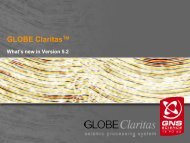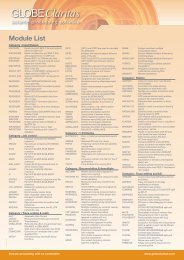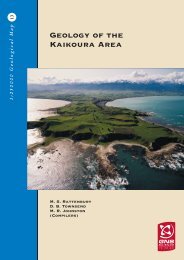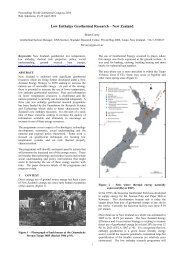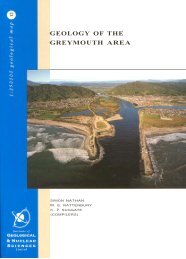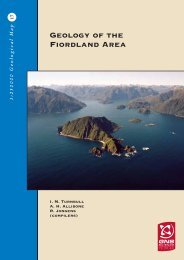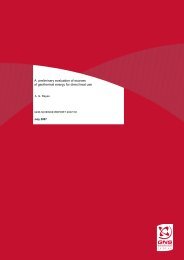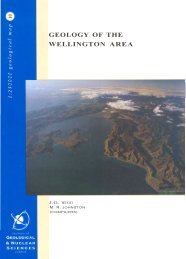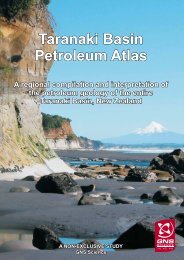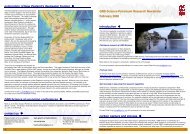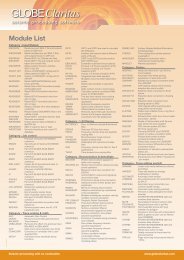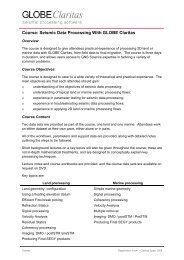GEOLOGY OF THE - GNS Science
GEOLOGY OF THE - GNS Science
GEOLOGY OF THE - GNS Science
Create successful ePaper yourself
Turn your PDF publications into a flip-book with our unique Google optimized e-Paper software.
Figure 21 The shore platform atRaukokore (Y14/4 13844; facingwest) exposes steeply dipping,Late Cretaceous TikihoreFormation alternating sandstoneand mudstone; the direction ofyounging is to the left. TheTikihoreFormation in this area is about3000 m thick. Photo CNI2973136:D.L. HomerWithin the East Coast All ochthon the formation istypically thinner bedded and more monotonous than inthe lower Mata River. lnoceram id fossil s are common inplaces, but conspicuous barren zones are present in thecoastal sections north of the Raukokore Ri ver. At GretePoint the Teratan interval includes 130 m of alternatingcentimetre-bedded green mudstone (siltstone), red andgreen muddy sandstone, a nd g rey cross-beddedsandstone, perhaps of sim ilar origin to the colouredmudstones present within the correlati ve KarekareFormation at Mangaotane.Tikihore Formation is estimated to be up to 3000 m thick.The base is commonly a fau lt contact. North oFTapuaeroaRiver the Tikihore Formation grades up ward into theoverl ying Tapuwaeroa Formation and the two may be, inpart, lateral eq uivalents. Where there is no TapuwaeroaFormation the Tikihore Formation grades upward intoWhangai Form ation. The kn ow n age range isCenomanian to Santonian (Ngaterian-Piripauan).The Tapuwaeroa Formation (Krp; Wellman 1959;Mazengarb 1993) consists of moderately indu rated,decimetre- to metre-bedded, sandston e-dominated,alternatin g sandstone and mudstone, with min orconglomerate, breccia and mudstone. Large areas ofTapuwaeroa Formation are present within the East CoastAllochthon between the Tapuaeroa and Waikura va lleys,northern Raukumara Peninsula.Tapuwaeroa sandstones are more quartzose than thoseof older Ruatoria Group Formmions and contai n moreplant frag ments and carbonaceous material, glauconiteand mica. Ind ividual sandstones are up to 6 m thick;sandstones are typically graded with Bouma sequencesedimentary structures. Piripauan inoceramid s (e.g./. australis ~Uld /. pacificLis pacificus, Crampton 1996)are common in coarse-grained sandstone and pebblysandstone beds, as is the sma ll oyster OSfrea lapillicola,a characteristic Fossil. Tapuwaeroa Formation is 1150 mthick at Wa io ro ngomai River, the type secti on(Mazengarb 1993), and it ranges in age from Coniacianto Campani an (latest Teratan-Hau muri an).Late Cretaceous to Paleocene sedimentary rocksWhangai Formation (Kiw) rocks within the East CoastAllochthon are mai nly attributed to the Eastern Facies(Fig. 22; Moore 1988b). The rocks consist of poorlybedded, light blue-grey weathering, medium grey, slightlyto moderately calcareous, micaceous, siliceous mudstoneof the Upper Calcareous Member and well bedded, lightgrey to white, hard, moderately calcareous mudstone, inplaces with beds of g la uconit ic sand stone, of thePorangahau Member. The form ation rests conformablyon the Tikihore and Tapuwaeroa formations wi th agradatio nal contact. The largest s in g le area ofallochthonous Whangai Formation covers about 75 km 2in the headwaters of the Waipaoa River, thrust overyounger rocks of the Weber and Wanst.ead formations,and overlai n by Tolaga Group mudstonc of Early Mioceneage. Large areas of Whangai Formation are present inthe vici nity of the confluence of the Mata and Tapuaeroari vers, near Ruato ria. Here, Whangai mudst.one is thrustover Tapuwaeroa Formation, overthrust by a structurallyhig he r thrust sheet of Early Cretaceous MokoiwiFormation and unconfor mabl y overlain by in-placeMiocene-Pliocene sandstone of the Mangaheia Group.Porangahau Member calcareous mudstones are present25



